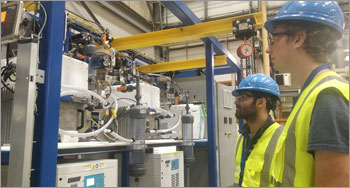Chemical manufacturing through electrochemical carbon dioxide utilization

CERT team observing operation of CO2 electrolyzers
Sector - Focus area
Manufacturing - CO2 capture and utilization
Status
Completed
Partners
The University of Toronto
Total American Services
Fund
Energy Innovation Program
Year
2019
EIP Contribution
$ 1,400,000
Project Total
$ 2,511,755
Location
Toronto, Ontario
Find out more
Lead Proponent
CERT Systems Inc.
Project Background
CERT Systems Inc. (“CERT”) is an early-stage carbontech company commercializing technology to transform greenhouse gases into valuable chemicals and fuels. This technology, called CO2 electrolysis, uses clean electricity and water to split carbon dioxide and reform it into molecules such as ethylene, ethanol, and methane.
In this project, CERT worked to advance technology developed at the University of Toronto. To demonstrate commercial feasibility, this project addressed a number of aspects that have been underexplored in academic research. Key technical barriers addressed included:
- Single pass utilization (SPU): the amount of CO2 consumed in one pass through the system, avoiding costly recirculation. This project targets 50% SPU
- Stability: how long the system functions at high performance without requiring replacement of parts. This project targets 1000 hours.
- Low concentration CO2 feedstock: most CO2 sources are dilute and expensive to purify to 100%. This project targets the use of 80% CO2.
Results
CERT was also able to exceed its technical targets during this project. While many reports on CO2 electrolysis have been limited to 100 hours of demonstration or less, CERT was able to demonstrate a robust system with over 1400 consecutive operating hours. Improvements to CO2 utilization were also achieved, with over 50% of CO2 converted within a single pass. Finally, it was shown that CO2 concentration could be dropped to 50% without loss in performance, meaning that ultra-high purity CO2 is not necessary.
This project allowed CERT to rapidly grow its CO2 conversion research team. The company expanded from only two employees to 14 full time employees by project end. As a result of the support of this project, CERT has been able to secure over $6M in non-dilutive follow-on funding.
Prior to NRCan BESC funded project CERT competed as a finalist in the NRG COSIA Carbon XPRIZE competition, which sought to identify the most promising routes to convert CO2 into useful products. During the competition, the team scaled up a pilot CO2 electrolyzer by over 10000 times from the lab scale electrolyzer. The unit was deployed at a natural gas power plant in Alberta. For the first time, the electrochemical production of ethylene from an industrial CO2 source was demonstrated.
Benefits to Canada
This project supports Canada’s innovation in carbon management. The funding supported an early-stage spin-out from a leading Canadian university, enabling CERT to establish an independent lab and grow its team seven-fold. Through this project, CERT directly employed and trained over 10 Highly Qualified Personnel, including undergraduate co-op students from Canadian universities.
The technology advanced in this project has significant potential for addressing CO2 emissions while generating economic value. Ethylene has an annual global market of about $200 B and is responsible for hundreds of millions of tonnes of CO2 emissions. CERT’s Canadian-developed technology provides a pathway to create significant value from existing CO2 emissions.
Next steps
CERT will continue to develop the technology with two complementary pathways:
- Point-source: Using gas phase CO2 input as presented in this project. CERT has started an industrial collaboration around this process and will seek to abate emissions from a range of industrial sectors.
- Direct air capture (DAC): Using liquid phase carbonate as a feedstock. CERT has secured funding through the Breakthrough Energy Fellowship to develop this pathway.
Future work will focus on further scaling the technology while making improvements to durability and efficiency.
Technology in Action

CERT’s prototype electrolyzer
In Their Words
“The BESC program has been transformative for CERT Systems. By supporting us at our earliest stages, BESC support has allowed us to grow our team, advance our technology, and build new partnerships. We have demonstrated that we have the leading solution for electrochemical conversion of CO2 into ethylene, one of the world’s most widely used chemicals.”

Christine Gabardo, Chief Technology Officer and Co-founder
Page details
- Date modified: